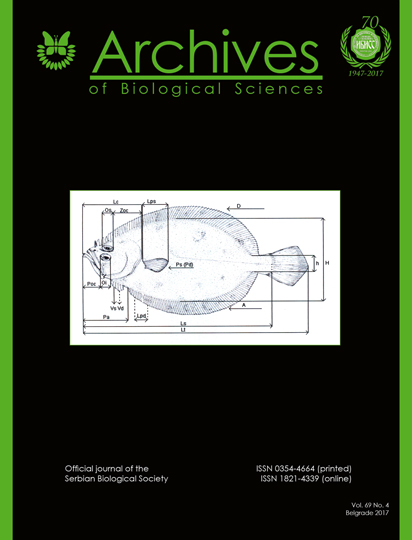Generation of human induced pluripotent stem cells from adipose-derived stromal/stem cells isolated from a 75-year-old patient
Keywords:
adipose cells, stem cells, reprogramming, transcription factorAbstract
Human adipose-derived stromal/stem cells (hASCs) have been considered a valuable cell source for generating induced pluripotent stem cells (iPSCs). Adipose tissue is easy to obtain. Moreover, the isolated cells rapidly proliferate to reach the required number of cells. Some authors have already shown that iPSCs can be successfully obtained using adult hASCs. Nevertheless, little is known about the generation of iPSCs using hASCs isolated from the tissues of patients over the age of 70. In this study, we examined the generation of iPSCs from hASCs isolated from a 75-year-old man. We transduced hASCs with human transcription factors OCT4, SOX2, c-MYC and KLF4 and observed the formation of human embryonic stem cell (hESC)-like colonies. The efficiency of the reprogramming process was 0.08% at day 18 post-infection. Reprogrammed cells expressed pluripotent state-specific transcription factors OCT4, SOX2, NANOG and KLF4, and were able to differentiate into three germ layers in vitro.
https://doi.org/10.2298/ABS170313018S
Received: March 13, 2017; Revised: May 10, 2017; Accepted: May 17, 2017; Published online: June 6; 2017
How to cite this article: Stoyanova E, Oreshkova T, Mourdjeva M. Generation of human induced pluripotent stem cells from adipose-derived stromal/stem cells isolated from a 75-year-old patient. Arch Biol Sci. 2017;69(4):715-21.
Downloads
References
Han W, Zhao Y, Fu X. Induced pluripotent stem cells: the dragon awakens. BioScience. 2010;60(4):278-85.
Lee Y-H, Mottillo EP, Granneman JG. Adipose tissue plasticity from WAT to BAT and in between. Biochim Biophys Acta. 2014;1842(3):358-69.
Takahashi K, Tanabe K, Ohnuki M, Narita M, Ichisaka T, Tomoda K, Yamanaka S. Induction of pluripotent stem cells from adult human fibroblasts by defined factors. Cell. 2007;131(5):861-72.
Aasen T, Raya A, Barrero MJ, Garreta E, Consiglio A, Gonzalez F, Vassena R, Bilic J, Pekarik V, Tiscornia G, Edel M, Boue S, Izpisua Belmonte JC. Efficient and rapid generation of induced pluripotent stem cells from human keratinocytes. Nat Biotech. 2008;26(11):1276-84.
Kim JB, Sebastiano V, Wu G, Araúzo-Bravo MJ, Sasse P, Gentile L, Ko K, Ruau D, Ehrich M, van den Boom D, Meyer J, Hubner K, Bernemann C, Ortmeier C, Zenke M, Fleischmann BK, Zaehres H, Scholer HR.Oct4-Induced pluripotency in adult neural stem cells. Cell. 2009;136(3):411-9.
Zuk PA, Zhu M, Ashjian P, De Ugarte DA, Huang JI, Mizuno H, Huang J, Futrell JW, Katz AJ, Benhaim P, Lorenz HP, Hedrick MH. Human adipose tissue is a source of multipotent stem cells. Mol Biol Cell. 2002;13(12):4279-95.
Dicker A, Le Blanc K, Aström G, van Harmelen V, Götherström C, Blomqvist L, Arnera P, Rydén M.. Functional studies of mesenchymal stem cells derived from adult human adipose tissue. Exp Cell Res. 2005;308(2):283-90.
Sun N, Panetta NJ, Gupta DM, Wilson KD, Lee A, Jia F, Hu S, Cherry AM, Robbins RC, Longaker MT, Wu JC. Feeder-free derivation of induced pluripotent stem cells from adult human adipose stem cells. Proc Natl Acad Sci U S A. 2009;106(37):15720-5.
González-Cruz RD, Fonseca VC, Darling EM. Cellular mechanical properties reflect the differentiation potential of adipose-derived mesenchymal stem cells. Proc Natl Acad Sci U S A. 2012;109(24):E1523-E1529.
Kang S-J, Park Y-I, Kwon M-J, Yang Y-H, Bang S-I, Sohn S-H, Park YH, So BJ, Kang H-GE.. Adipose stromal cells are a more efficient source than adipose stem cells in retrovirus-mediated iPS induction. Cell Mol Bioeng. 2015;8(1):224-35.
Stoyanova E, Mourdjeva M, Kyurkchiev S. Early selection of human fibroblast-derived induced pluripotent stem cells. Biotechnol Biotechnol Equip 2015:29(5):942-8.
Kim D, Kim CH, Moon JI, Chung YG, Chang MY, Han BS, Ko S, Yang E, Cha KY, Lanza R, Kim KS, Generation of human induced pluripotent stem cells by direct delivery of reprogramming proteins. Cell stem cell. 2009;4(6):472-6.
Pfaffl MW. A new mathematical model for relative quantification in real-time RT–PCR. Nucleic Acids Res 2001;29(9):e45.
Takahashi K. Induction of pluripotent stem cells from adult human fibroblasts by defined factors. Cell. 2007;131:861-72.
Lowry WE, Richter L, Yachechko R, Pyle AD, Tchieu J, Sridharan R, Clark AT, Plath K.. Generation of human induced pluripotent stem cells from dermal fibroblasts Proc Natl Acad Sci U S A. 2008;105(8):2883-8.
Lapasset L, Milhavet O, Prieur A, Besnard E, Babled A, Aït-Hamou N, Leschik J, Pellestor F, Ramirez J-M, Vos JD, Lehmann S, Lemaitre J-M Rejuvenating senescent and centenarian human cells by reprogramming through the pluripotent state. Genes Dev. 2011;25(21):2248-53.
Prigione A, Hossini AM, Lichtner B, Serin A, Fauler B, Megges M, Lurz R, Lehrach H, Makrantonaki E, Zouboulis CC, Adjaye J. Mitochondrial-associated cell death mechanisms are reset to an embryonic-like state in aged donor-derived iPS cells harboring chromosomal aberrations. PLoS ONE. 2011;6(11):e27352.
Ohmine S, Squillace KA, Hartjes KA, Deeds MC, Armstrong AS, Thatava T, Sakuma T, Terzic A, Kudva Y, Ikeda Y. Reprogrammed keratinocytes from elderly type 2 diabetes patients suppress senescence genes to acquire induced pluripotency. Aging (Albany NY). 2012;4(1):60-73.
Mitsui K, Tokuzawa Y, Itoh H, Segawa K, Murakami M, Takahashi K, Maruyama M, Maeda M, Yamanaka S. The homeoprotein Nanog is required for maintenance of pluripotency in mouse epiblast and ES cells. Cell. 2003;113(5):631-42.
Nichols J, Zevnik B, Anastassiadis K, Niwa H, Klewe-Nebenius D, Chambers I, Schöler H, Smith A. Formation of pluripotent stem cells in the mammalian embryo depends on the POU transcription factor Oct4. Cell. 1998;95(3):379-91.
Banito A, Rashid ST, Acosta JC, Li S, Pereira CF, Geti I, Pinho S, Silva JC, Azuara V, Walsh M, Vallier L, Gil J. Senescence impairs successful reprogramming to pluripotent stem cells. Genes Dev. 2009;23(18):2134-9.
Downloads
Published
How to Cite
Issue
Section
License
Authors grant the journal right of first publication with the work simultaneously licensed under a Creative Commons Attribution 4.0 International License that allows others to share the work with an acknowledgment of the work’s authorship and initial publication in this journal.




